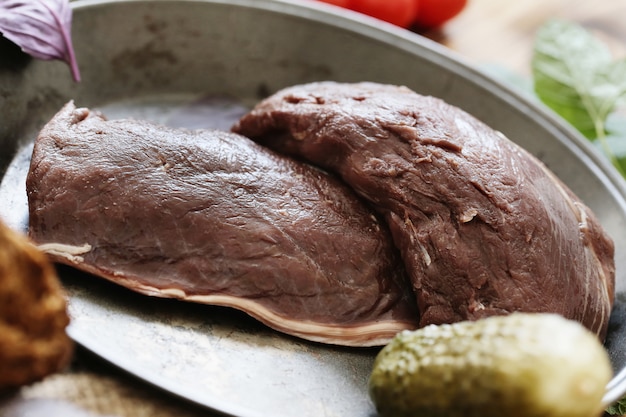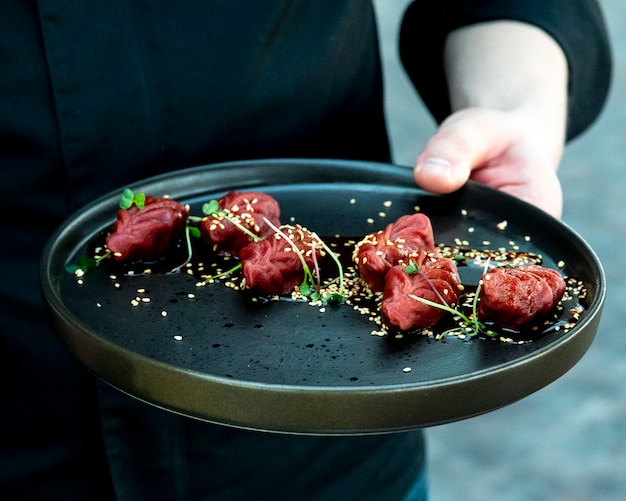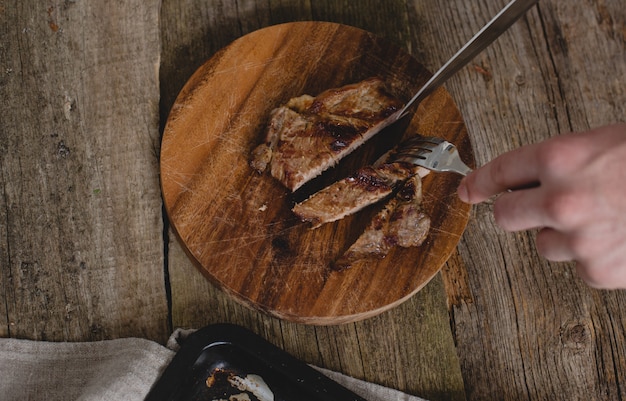Ah, venison tenderloin. Just the name evokes images of a rich, flavourful meal that’s sure to impress. But let’s be honest, it can also be a bit intimidating. Getting it right isn’t just about throwing it on the grill and calling it a day. You need to understand the nuances of this exquisite cut and know the tricks to unlock its full potential. So, buckle up, because I’m taking you on a journey to master the art of cooking venison tenderloin. From selecting the perfect piece to nailing the cooking methods and sides, I’ll share everything I’ve learned over years of experimenting, triumphs, and, yes, a few culinary mishaps along the way. Let’s get started!
(Part 1) Choosing the perfect venison tenderloin

The first step to a truly delicious venison tenderloin is choosing the right piece. You want something that’s going to be juicy, flavourful, and melt in your mouth, not tough and dry. It all starts with making smart choices at the source.
1. The Source: Local is Lovely
I’m a firm believer in supporting local producers whenever possible. It’s not just about freshness; it’s about knowing where your food comes from and understanding the story behind it. For venison, local game suppliers are often your best bet. You can usually find them at farmers' markets or online. You'll often find that these suppliers can provide valuable information about the venison, such as the age of the deer and its diet, which gives you a better picture of what to expect in terms of flavour and texture. And hey, you're contributing to the local economy, which is always a bonus.
2. The Cut: Marbling Matters
Venison tenderloin is usually sold as a whole piece, but you might also find it sliced into medallions. I’m a fan of the whole tenderloin because it gives you more flexibility in how you cook it and how you serve it. When you’re choosing, remember the golden rule: look for marbling. That's the fat that runs through the meat, and it's what gives the venison its juicy flavour and tenderness. You want a good amount of marbling, but not too much.
3. The Colour: A Sign of Freshness
The colour of the venison can be a good indicator of its freshness. A healthy piece of venison will have a deep, rich red colour, not brown or discoloured. You'll also want to make sure the texture is firm and not mushy. A good piece of venison should have a spring to it, not feel limp.
(Part 2) Preparing the Venison Tenderloin

Alright, you’ve got your beautiful piece of venison. Now it’s time to get your hands dirty and prepare it for cooking. This is where you can really make your mark and add those extra layers of flavour.
1. Trimming and Seasoning: A Foundation for Flavour
First, grab a sharp knife and trim off any excess fat or connective tissue. You want a little bit of fat for flavour, but too much can make it greasy. You'll also want to trim off any silver skin, which is that tough membrane that can make the meat chewy. Now, onto the fun part: seasoning! Venison is incredibly versatile, so don’t be afraid to experiment. I often start with a simple blend of salt, pepper, and garlic powder, but you can get creative with herbs like rosemary, thyme, and sage, or even a pinch of chili powder for a kick. You can also use a dry rub, which is a blend of spices that you rub onto the meat before cooking. It's a great way to add depth of flavour.
2. Marinating (Optional): A Bath in Flavour
Marinating is a great way to infuse your venison tenderloin with even more flavour and moisture. It's like giving it a bath in flavour! A simple marinade of olive oil, lemon juice, and your favourite herbs can work wonders. If you want to get fancy, try a red wine marinade or a mix of soy sauce and ginger. Just remember to marinate for at least 30 minutes, or even overnight for maximum flavour. The longer, the better!
3. Resting: A Crucial Step for Even Cooking
Once your venison is prepped and seasoned, it's important to let it rest at room temperature for about 30 minutes before cooking. This may seem counterintuitive, but it helps to ensure that the meat cooks evenly and doesn't become tough. The meat will cook more uniformly if it’s not going from the refrigerator straight to the heat. Believe me, I've learned this the hard way through a few too many dry venison dishes. It's worth the extra wait!
(Part 3) Cooking Methods: From Searing to slow roasting

Now, you’re ready to cook. The right cooking method can make a world of difference. Each one brings its own unique flavour profile and level of effort, so find what suits you best.
1. Searing: A Quick and Delicious Crust
This is my go-to method when I’m short on time but still want a delicious meal. Simply heat up a heavy pan over high heat, add a bit of oil, and sear the tenderloin on all sides until it’s nicely browned. This creates a delicious crust that seals in the juices. For an extra layer of flavour, I often add a few sprigs of rosemary or thyme to the pan during searing.
2. Pan-Frying: A Balanced Approach
Pan-frying is similar to searing, but you'll cook the tenderloin for a longer period to ensure it’s cooked through. I prefer to pan-fry over medium heat, which allows the meat to cook evenly. Remember to use a meat thermometer to check the internal temperature. Venison is best cooked to medium-rare, about 145°F, but you can adjust this to your liking.
3. Roasting: Perfect for a Crowd
Roasting is a great option when you’re feeding a crowd. It's a simple method that produces succulent and flavourful meat. Preheat your oven to 375°F. Place the tenderloin on a rack in a roasting pan and cook for about 15-20 minutes per pound. Let the meat rest for 10-15 minutes before carving.
4. Slow Roasting: A Masterclass in Tenderness
For a truly melt-in-your-mouth tenderloin, try slow roasting. It’s all about low and slow cooking, resulting in beautifully tender and flavorful venison. Preheat your oven to 275°F. Place the tenderloin on a rack in a roasting pan and cook for about 2-3 hours, or until the internal temperature reaches 145°F.
5. Grilling: Summertime Delight
Grilling is another great way to cook venison tenderloin, especially during the summer months. Preheat your grill to medium-high heat. Make sure to oil the grates to prevent sticking. Cook the tenderloin for about 5-7 minutes per side. I like to use a marinade for grilling as it adds extra flavour and keeps the meat moist.
(Part 4) Cooking Temperatures and Doneness: A Guide to Perfection
Now, let’s talk about the crucial element of cooking venison tenderloin: getting the doneness just right! It’s all about finding that perfect balance of tenderness and flavour. Overcooking venison is a culinary tragedy, resulting in dry, tough meat.
1. Doneness and Internal Temperature: A Chart for Success
Here’s a guide to internal temperatures and doneness levels to help you find that perfect spot:
| Doneness | Internal Temperature |
|---|---|
| Rare | 125°F |
| Medium-Rare | 135-145°F |
| Medium | 145-155°F |
| Medium-Well | 155-165°F |
| Well-Done | 165°F and above |
Remember, venison is best cooked to medium-rare or medium.
2. Using a Meat Thermometer: A Chef's Secret Weapon
The best way to determine the doneness of your venison tenderloin is to use a meat thermometer. It’s a simple tool that can make all the difference. Insert the thermometer into the thickest part of the meat, making sure it doesn’t touch bone. If you want to be extra sure, you can insert the thermometer in a couple of different spots to make sure the internal temperature is consistent.
3. Resting: A Final Act of Tenderness
Once your venison tenderloin is cooked to your desired doneness, let it rest for 10-15 minutes before carving. This allows the juices to redistribute throughout the meat, resulting in a juicier and more flavorful tenderloin. It's a simple step that makes a huge difference in the final result.
(Part 5) Serving the Venison Tenderloin: A Symphony of Flavour
Now that you’ve mastered the art of cooking venison tenderloin, it's time to put your culinary skills to the test and serve it up. Here are a few ideas to make your meal extra special.
1. Slicing and Carving: A Beautiful Presentation
To slice and carve the tenderloin, cut it into thin, even pieces. You can use a sharp chef's knife for this, or a carving knife for a more elegant touch.
2. Sides and Sauces: A Culinary Ensemble
Venison tenderloin goes wonderfully with a variety of sides and sauces. Some of my favourites include:
- Roasted root vegetables like potatoes, carrots, and parsnips. The earthy sweetness of these vegetables complements the rich flavour of the venison perfectly.
- Creamy polenta or risotto. These creamy dishes provide a comforting and satisfying contrast to the venison.
- A simple green salad with a vinaigrette dressing. A fresh salad adds a bright and refreshing touch to the meal.
- Wild mushroom sauce. The earthy, umami flavour of mushrooms pairs beautifully with venison, adding another layer of depth.
- Cranberry sauce. The tartness of cranberry sauce cuts through the richness of the venison, creating a delicious balance.
- A red wine reduction. A rich and complex red wine reduction adds another dimension of flavour to the venison.
3. Presentation and Garnishing: A Feast for the Eyes
For a truly impressive presentation, arrange the sliced venison tenderloin on a platter with your chosen sides and sauces. Garnish with fresh herbs like rosemary or thyme, a drizzle of olive oil, or a pinch of flaky sea salt. This final touch adds a burst of colour and freshness to your dish.
(Part 6) Storing and Leftovers: Making the Most of Every Bite
Now, let’s talk about storing your venison tenderloin and what to do with leftovers.
1. Storage: Keeping it Fresh
To store cooked venison tenderloin, let it cool completely, then place it in an airtight container and refrigerate for up to 3-4 days.
2. Freezing: Saving for Later
You can also freeze cooked venison tenderloin for up to 2-3 months. Wrap it tightly in plastic wrap and then in foil, or use a freezer-safe container.
3. Leftovers: A culinary adventure
Leftover venison tenderloin can be used in a variety of dishes. Try slicing it thin and adding it to a salad, stir-fry, or pasta dish. You can also make a venison hash or use it as a filling for sandwiches.
(Part 7) Tips and Tricks: Mastering the Art of Venison
Alright, let’s delve into some helpful tips and tricks to make your venison tenderloin experience even better.
1. Don’t Overcook: A Culinary Sin
I've been there, and it's not a good look! Venison is best cooked to medium-rare or medium, and overcooking it will make it tough and dry.
2. Use a Meat Thermometer: Your Culinary Compass
As I mentioned before, a meat thermometer is your best friend when cooking venison. It takes the guesswork out of ensuring your tenderloin is cooked to perfection.
3. Let It Rest: A Moment of Relaxation
Resting the tenderloin after cooking allows the juices to redistribute, resulting in a more tender and flavorful dish. Don’t skip this step.
4. Experiment with Flavours: Embracing Culinary Creativity
Venison is incredibly versatile and can be paired with a variety of flavours. Don’t be afraid to experiment with different herbs, spices, and marinades.
5. Serve It with the Right Sides: A Symphony of Taste
Pair your venison tenderloin with sides that complement its flavour, such as roasted root vegetables, creamy polenta, or a green salad.
(Part 8) FAQs: Answering Your Questions
I’ve gathered some of the most common questions people have about venison tenderloin. Let’s dive in!
1. Is venison tough?
Venison can be tough if it’s not cooked properly. The key is to cook it to medium-rare or medium, and to let it rest after cooking.
2. What does venison taste like?
Venison has a rich, gamey flavour that’s similar to beef, but with a slightly more intense flavour. It's often described as having a slightly sweet and nutty flavour.
3. How do you know if venison is bad?
Venison that’s gone bad will have a strong, unpleasant odour. It may also have a slimy texture or a discoloured appearance.
4. What is the best way to cook venison tenderloin?
The best way to cook venison tenderloin is to sear it, pan-fry it, roast it, or grill it. Each cooking method produces a unique flavour profile.
5. What can you serve with venison tenderloin?
Venison tenderloin goes well with a variety of sides, such as roasted root vegetables, creamy polenta, a green salad, wild mushroom sauce, cranberry sauce, or a red wine reduction.
There you have it - the ultimate guide to perfect venison tenderloin cooking! I hope this article has equipped you with the knowledge and confidence to create a delicious and unforgettable meal. Remember, it’s all about choosing the right cut, preparing it properly, and cooking it with care. Now, go forth and impress your friends and family with your newfound expertise! And don’t forget to share your culinary creations with me – I love seeing what you’ve cooked up!
Everyone is watching

How to Cook Frozen Lobster Tails Perfectly: A Step-by-Step Guide
RecipesLobster. Just the word conjures up images of lavish meals, special occasions, and a taste of luxury. But let's...

Pigs in a Blanket Cooking Time: How Long to Bake for Perfect Results
RecipesAh, pigs in a blanket. Just the name conjures up images of those delightful little parcels of crispy pastry en...

Pork Fillet Cooking Time: How Long to Cook It Perfectly
RecipesPork fillet, or tenderloin as it's sometimes called, is a real favourite in our house. It's so versatile, and...

The Ultimate Guide to Cooking Delicious Frankfurters
RecipesLet's face it, we all love a good frankfurter. It's a classic, simple, and always satisfying. But let's be rea...

Wolf Meat Recipes: A Guide to Cooking Wild Game
RecipesLet's be honest, you don't see wolf meat at your local butcher shop every day. It's a bit of a wild card, but ...
